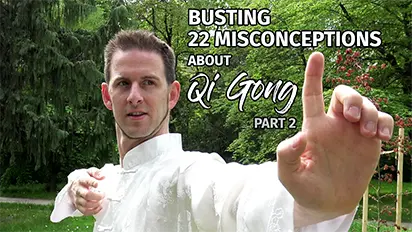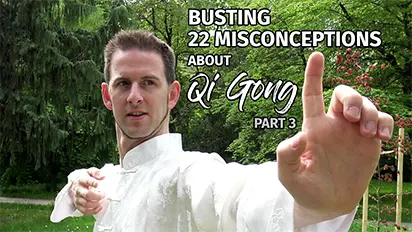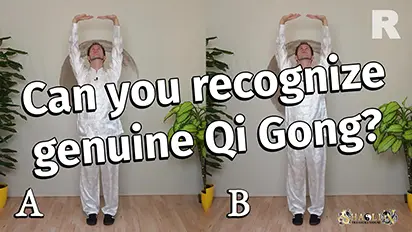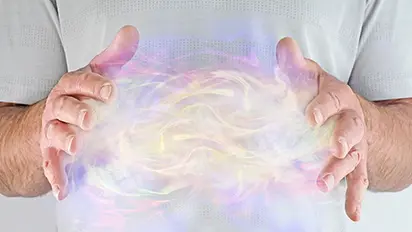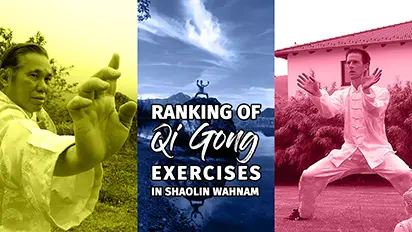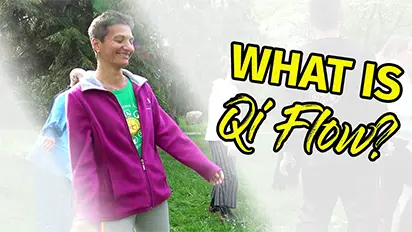Busting 22 Misconceptions About Qi Gong - Part 1/3
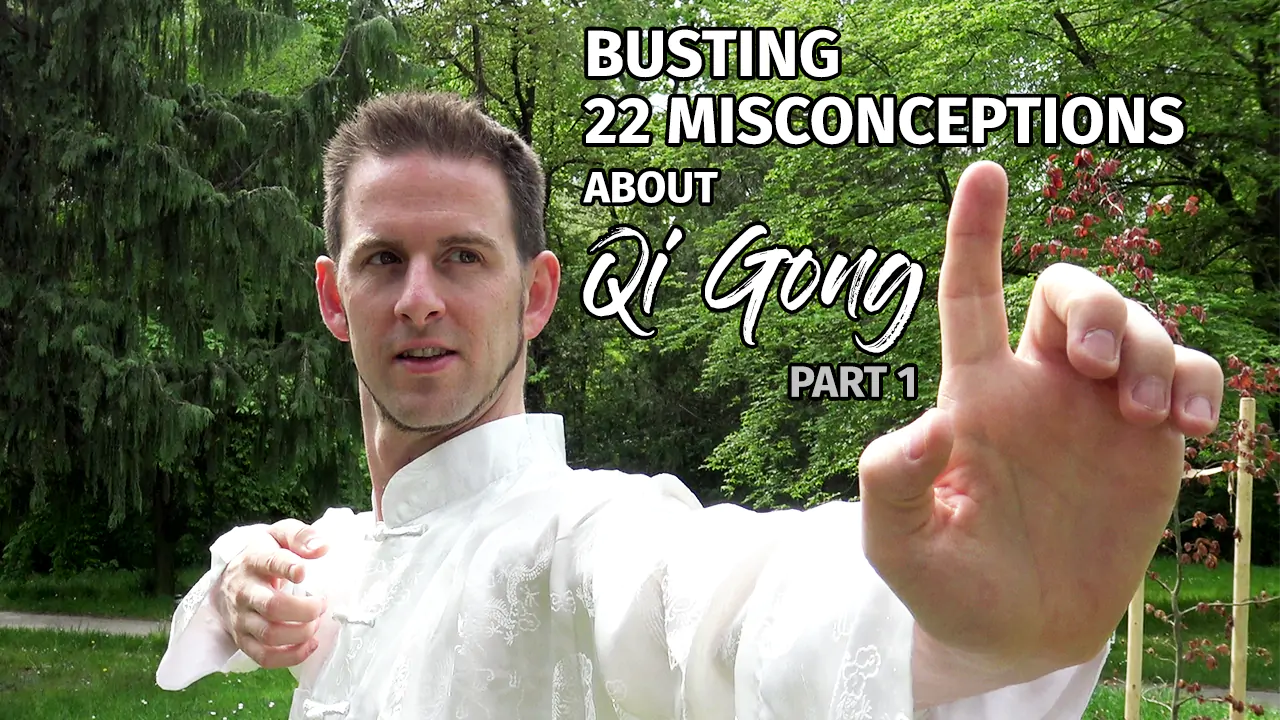
Authentic Energy Work or cheap Imitation?
Understanding an art is a mixture of acquired knowledge and personal experience.
Thanks to direct transmission and written records, the Shaolin arts represent the accumulated knowledge of countless masters over 1,500 years. Unfortunately, they were initially banned by the Communist Party during the Cultural Revolution in China and later revived in a superficial, appearance-focused version.
In the West, they have been altered by influences from the New Age movement and other energy arts, or misinterpreted and distorted through incompatible Western worldviews and medical theories.
How can you know today which of the many schools, styles and teachers still follow the original tradition and which are just passing on a diluted imitation?
The fact that the visible aspect, the external form, is often identical makes it particularly difficult to discern genuine energy practice from gentle gymnastics.
The best indicator is whether you achieve the results promised by practicing an art. First, you should know what is possible with this art and then not just be satisfied with the minimum benefits.
Qi Gong is supposed to enable you achieve robust health, emotional balance, vitality and peak performance, as well as a clear mind, not just improve mobility and provide short-term relaxation.

The correct execution of techniques is advantageous, but by far not the most important thing in Qi Gong.
Theory and goals should always be confirmed through personal experience. Unfortunately, many styles and teachings do not pass this test, as numerous of our students report after experiences in other schools.
With this guideline on common misconceptions and false information about Qi Gong, it will be easier for you to expose inferior styles and inexperienced teachers and to find the few authentic schools and masters.
If you’re already practicing Qi Gong, you may find some points that you can stop worrying about, which in turn will improve the effectiveness of your practice.
An art or practice that provides no or only minimal benefits cannot be authentic, as it would have been sifted out during the centuries-long evolution.
Because a large part of the supposed Qi Gong practitioners actually only practices gentle gymnastics and not energy work, and because many begin teaching before they themselves have reached an appropriate depth in their practice, the public image and general level of Qi Gong is shockingly low.
Many teachers try to compensate for lack of skill and weaknesses in their style by using knowledge taken out of context, mythical descriptions and unfounded theories. Through unnecessary or even incorrect instructions, they hinder the progress of their students, wittingly or unwittingly. Although they mean well, they do not do the long tradition of energy arts any good and reinforce many misconceptions and false information.
Some of the following statements may contain inconvenient truths and wake up calls.
It’s not my intention to offend any genuine masters and teachers who sincerely try to share goodness.
At the same time, I want to provide you with helpful information to find a genuine teacher or to improve your existing Qi Gong practice.
So, let’s debunk some common myths and misunderstandings, starting with a crucial one that serves as a good introduction!
All Qi Gong is the same
There are many Qi Gong traditions and countless styles. I’ll write about those in another blog post, but for the time being I’ll just provide a brief overview.
Although Qi Gong is non-religious by itself, its three main backgrounds are Taoist, Buddhist and Confucian cultivation.
Some types of practice focus on health, others on peak performance and further ones on attaining spiritual fulfilment. Some schools cover only one of those aspects, others contain all of them, according to the needs and state of development of their students.
More important than the style though is the effectiveness of its practice, or in other words, the teaching methodology used.
There are huge differences when it comes to the intensity and cost-effectiveness of Qi Gong.
Actually, most people don’t really practice Qi Gong, or energy work, when performing the gentle movements. They miss its essence because they were never introduced to the crucial internal aspects and fundamental skills involved.
It is no exaggeration that about 80% of practitioners just practice gentle gymnastics that look like Qi Gong. They may achieve a sense of relaxation and well-being, but they fail to unlock the deep and transformative effects of genuine Qi Gong.
This video, including some demonstrations, may help you understand what I mean with that.
Among those lucky 20% who exercise authentic energy practice, there are still huge differences. Some need to practice for 1 or 2 hours a day to achieve a bit of Qi Gong benefit. 30-45 minutes per session is a common average.
Only 5% of those 20% are blessed with high-level Qi Gong that enables you to achieve deep and fast results with little effort. For example, we instruct our students to practice for 10-15 minutes once or twice a day and the results are outstanding, sometimes miraculous.
So, choose your master wisely! And search for a master in the first place, instead of choosing a random teacher just because they’re teaching at the gym around the corner. My free E-Book can be of help with that.
When approaching another school or style, “empty your cup”, as the method, instructions and exercises could be completely different.
Qi = Breath
Qi is often mistakenly translated as “breath„. While breath is indeed one of the possible translations of the Chinese character for Qi (氣, also Chi), in the context of Qi Gong practice, it does not refer to the modern interpretation of breath as the inhaling of oxygen and exhaling of carbon dioxide.
Due to this incorrect translation, some people understand "Qi Gong" as a breathing exercise only.
We have to consider that this traditional art originates from ancient times and had strong impact on the Chinese language. The classical function and understanding of breathing are to exchange energy with the cosmos (or environment).
However, the meaning of the term is actually "the Art of Energy", while breath does play an important role in the practice.
Qi does not exist
Therefore, it is all the more surprising that even some Western Qi Gong or Tai Chi teachers doubt the existence of energy and try to explain the effects in a Western way. It is often mentioned that the oxygen content in the blood increases and stress hormones and inflammation values decrease. While these effects are correct, they are only a symptom or the result of the improved flow of energy, which is the basis of any effect in Traditional Chinese Medicine (TCM), and thus also in Qi Gong.
Even Western science agrees that any matter, from aeroplanes and humans to atoms in the air, is fundamentally made up of energy. Therefore, it is simply ignorant not to acknowledge the existence of Qi (or energy), though measuring instruments are not well-known to the public.
"Master" teachers who teach the techniques of Qi Gong or Tai Chi but deny the existence of Qi or dismiss it as esoteric have obviously not experienced it themselves. Their practice and teaching are therefore limited to the least important, the physical level. Since they do not practice authentic Qi Gong, they should question their own practice instead of energy in general.
Most of those who practice genuine Qi Gong for some time are able to feel Qi.
A student of one of my Shaolin brothers felt “a stream inside his body where something was flowing” during his first session. He also became able to feel his Dantian, or central energy field at the abdomen, quickly.
Those sensations are actually quite common in our school, but the interesting thing is that this student has a bachelor degree in theoretical physics called these happenings “the most surreal and at the same time most real” he ever experienced.
Being a fan of technology, logical thinking and admirer of science, I understand that this whole energy thing doesn’t fit into a modern worldview. But once you experience Qi first-hand, any doubt about its existence vanishes, as you can’t deny what you feel.
Qi Gong is (only) a Relaxation Exercise
Many people think that Qi Gong is only useful for relaxing after a stressful day at work.
However, relaxation is not only the goal of Qi Gong, but rather a prerequisite for being able to engage in authentic energy training in the first place.
“If you are not relaxed and focused, you may as well not practice because you will not get any benefit.”
Grandmaster Ho Fatt Nam
Qi Gong is an important pillar of Traditional Chinese Medicine and therefore has much more to offer than just "calming down".
Quantity over Quality
Especially in the West, skill is often equated with the amount of learned techniques and intellectual knowledge. However, what is more crucial are the skills that one develops through practice.
Someone who is able to generate good energy flow with 5 sloppy repetitions of the Qi Gong exercise "Lifting the Sky" without knowing why, has achieved much more than someone who can perform numerous exercises beautifully and explain their precise physiological and energetic mechanisms but only loosens their muscles and joints without experiencing any benefits of Qi Gong.
This is something, only those who experienced the difference can comprehend.
Ideally, there should be a good mix of skills and understanding, with skills always being given priority.
Even in terms of exercise duration, we emphasize to our students that "less is more". While we instruct them to practice daily, we always stress not to overdo it and risk negative effects by overtraining.
Practicing at noon / in the sun
Some schools and books instruct practitioners to do so, which is an indicator of low-quality practice.
Kung Fu and Qi Gong masters in the past used to wake up much earlier than others to practice during the sunrise, which is considered the best time for practice.
During noon and in direct sunlight, radiation and energy density are at their highest. Practicing authentic, high-quality Qi Gong may overload the practitioner's system. However, it is not a big issue for those doing gymnastic-style "Qi Gong" with no noticeable effect.
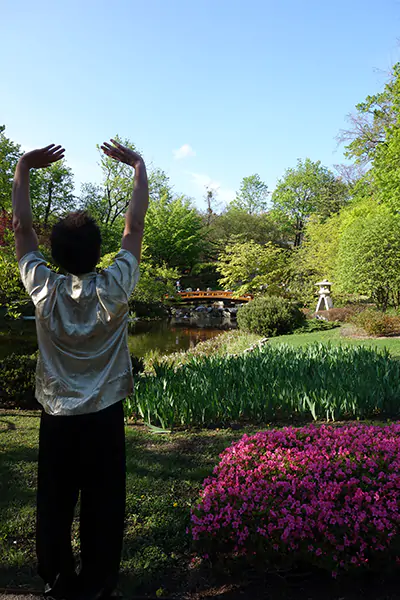
It is pleasant and ideal to practice Qi Gong in partial shade.
Qi Gong can be learnt from books or random videos alone
Yes, one can often learn the external form, i.e. the movements, very easily from well-written books, instructional DVDs, or even random YouTube videos. However, simply learning the movements alone does not mean that one can practice Qi Gong, i.e. effective energy training.
The difference is not apparent to laypeople. It is therefore not surprising that so many people think they can learn one of the highest arts that humanity has produced through self-study. Many people then think they can pass on what they have learned, which has led to the rapid decline of the art.
What makes Qi Gong energy work are skills. These should always be transmitted by a master or at least a good and experienced teacher. Ideally, in person. This way is much safer, far more efficient and has been proven over centuries.
However, well-structured online courses based on high-quality methods can also be very powerful and effective, as the effects reported by my students have shown.
I concluded that the most important factors that determine how far you can get are the quality of the method and how good your teacher is in transmitting it… provided you put into practice what you’ve learned. You can read more about that in my blog post “Can you learn Kung Fu online?” which applies to Qi Gong too.
Conclusion
Thank you for reading the first part of a three-part series on common misconceptions, diluted methodologies and misinterpretations surrounding Qi Gong. The goal of this series is not to devalue the hard work of other teachers but to emphasize that many of the offered styles have deviated far from their original power and efficacy.
Unfortunately, the false impression created harms the reputation of the few authentic schools and prevents many people from continuing their search after ineffective attempts.
Most people miss that Qi Gong is much more than the execution of relaxed gymnastics exercises.
As it is our responsibility to preserve and pass on the original Shaolin arts and their benefits, these articles aim to help you identify hollow instructions and poor theories. I am glad if these tips also help practitioners from other schools to improve the effectiveness of their own practice.
Stay tuned for the next parts of this series!
You'd like to know our special Shaolin Cosmos Qi Gong?
Then use this Online Mini Course to get
Although the course only scratches the surface, I’m always surprised by how enthusiastic many participants already are.
- Thank you very much for the great course… since I started practising the exercise, I feel much more relaxed.
- Feels amazingly good. Thank you so much. 🙏😊
- I really enjoyed it. It was informative and to the point. The exercise was explained very clearly and well structured. A beautiful exercise, presented in a very likeable way.
- This is incredibly soothing!
- Thank you for this wonderful exercise. Before practising I felt tired and low on energy, but now I clearly feel more energised and lighter.
- Very informative and easy to do — a great exercise that I will definitely keep using.
- Brilliant!
In my complete and in-depth course programs, I then teach the inner skills that will truly bring your practice to life.
Once students have learned those, their testimonials sound more like this:
This was the best Qigong course I have ever attended. Everything was perfect — the relaxed atmosphere, the detailed and well-founded explanations, and the presentation of the underlying philosophy that left no questions unanswered. You couldn’t design an online course any better.
- Klaus Micke
This course is exactly what I’ve been looking for for years! Finally, I can enjoy the Qi Flow instead of just experiencing gentle stretching and strengthening in a social setting at a sports club!
- Julia Holz
I enjoyed every practice session — and I still do. After each session, I feel refreshed and start the day with more energy than before. I’m still pleasantly surprised by what’s possible with just 15 minutes a day.
- Cora Hemken
Start now with the...
Related Topics:
Busting 22 Misconceptions About Qi Gong - Part 2/3
The series continues to bust common myths and misunderstandings about Qi Gong that leads to many people having a wrong conception of this powerful art.
June 17, 2023
Busting 22 Misconceptions About Qi Gong - Part 3/3
The final part of busting common myths and misunderstandings about Qi Gong that leads to many people having a wrong conception of this powerful art.
April 5, 2024
Can you recognize genuine Qi Gong?
Qi Gong Riddle. Do you recognize the difference between authentic Qi Gong and gentle gymnastics?
January 7, 2023
What does Qi feel like?
Although many people doubt its existence, practitioners of authentic Qi Gong report manifold effects and sensations of this vital energy. Have a look at this selection.
January 8, 2024
Ranking of Qi Gong Exercises in Shaolin Wahnam
There are many Qi Gong arts and skills in our school, whose benefits range from health to enhancing performance and spiritual cultivation.
August 1, 2023
What is Qi Flow?
Read about a precious Qi Gong skill that is quite unknown but so effective in clearing any blockages. Find out more about Shaolin Wahnam's hallmark.
January 19, 2024
Breadth & Depth in Learning (Qi Gong)
When learning Qi Gong, Kung Fu or any other art, you can progress in two dimensions. You can add quantity by learning more and depth by increasing your skills.
October 25, 2023
Categories
Shaolin Qi Gong
Shaolin Kung Fu
Martial Arts
Benefits
Learning
Customs & Moral Code
Sneak Peak
VLOG Video
History
Follow Us
Author

Sifu Leo
Shaolin Wahnam Instructor
Hey there!
I’m Sifu Leo, Kung Fu enthusiast, father, drummer and computer geek from Austria. And, as many say, a kind and patient person and teacher.
I'm happy to share the knowledge and methods taught to me by the outstanding Shaolin Grandmaster, Wong Kiew Kit, with you.


